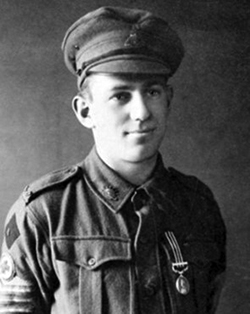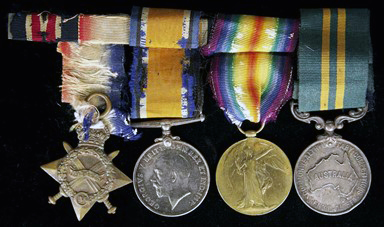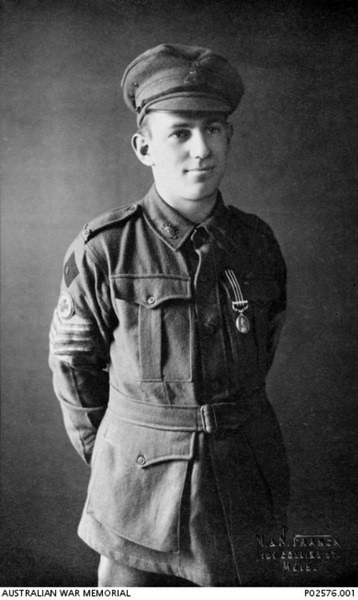Reginald A Hind MM

Ballarat City Rowing Club (Vic)
Sargeant Reginald Arthur Hind, Military Medal and Bar
Reginald Hind was born in Mentone in 1897. His father was Henry Dalzell Hind and his mother Alice Louisa Hind nee Evans. They moved to Ballarat in about 1894. They lived at 710 Sturt Street Ballarat and his father was a dental surgeon. Alice died in 1908 when Reg was only 10. He had a sister Ruth who was 10 years older than him and probably kept house for and his father. Reg attended the Ballarat Agricultural High School and was one of the High School boys who joined Ballarat City Rowing Club in 1912. While at school he was also in cadets and graduated to Senior cadets 71st Battallion,18th Brigade,3rd Military District.
Reg enlisted for WW1 on March 1st 1915 in Ballarat. He joined the 6th Field Ambulance. He was 18 years old and still a schoolboy at the time of enlistment. His unit embarked from Melbourne, Victoria on board HMAT A31 Ajana on the 4th of June 1915. On the 17th of July 1916, he was appointed Lance Corporal. He was promoted to Corporal on the 14th of January 1917, and then to Sergeant on the 1st of April 1917.
He was awarded the Military Medal on the 8th of August 1916 for the Battle of Pozieres. The citation reads “ For great gallantry as a stretcher bearer under heavy fire and continuing to work practically bare foot. During the attack at Pozieres he rescued a man from the danger area of a gas barrage and a few minutes later dressed and removed the same man and two stretcher bearers wounded by shrapnel. His conduct has already been bought to notice at ANZAC.”
He was awarded the Bar for the Military Medal on the 26th of September 1917 for the battle at Polygon Wood. He went on night duty on the 25th of September at the Culvert and moved up to Polygon Wood near Ypres on the 26th.He left his bearers in a safe position and went out alone to find the RAP which had moved up without leaving any location. Under intense shell and MG fire, being absent for two hours under fire, he returned, bought his bearers up and evacuated men who had been there for two days. By his courage and determination he re-established a line of evacuation which had broken down and kept the posts clear of wounded.
He was wounded November 1917 with severe shrapnel wounds to right side of his body. However his life was saved when the New Testament bible he carried in his top pocket actually stopped a bullet that would have killed him. He was sent to the 1st Western General Hospital. He had survived Gallipoli and the Western Front and returned to Australia on the troopship Orontes 10th of March 1918.
He was discharged on 25th of October 1918 and returned to Australia. During WW2 he became Welfare officer at Greta Soldier’s camp in NSW and was part of a Christian Missionary group SGM Australia .He died on 6th of April 1982 in NSW.
Kyabram Free Press and Rodney and Deakin Shire Advocate (Vic. : 1914 - 1918), Friday 4 February 1916, page 4 Soldiers Letter Bag.
THE BRAVE CONDUCT OF "TWO KIDS." DUDLEY BAIRD AND REG. HIND FACE A HAIL OF BULLETS.
Following is an extract from Harry Ellingsen letter to his father, dated December 10th, 1915, Egypt :
“I was talking to Dick Dowrie (in the hospital) for a long while, and he was telling me of some of the doings of our lads over on the Hill. He has only come back a week and he was saying that he thinks a few of the 6th Ambulance chaps are sure to be mentioned in dispatches. He specially mentioned Benson, Reg. Hind, and Dud Baird (Wyuna). Their pluck, self-sacrifice and level headedness under fire have been the admiration of all they have come in contact with. Two days before Dick came away from Anzac they received word for a stretcher party to proceed to the A.M.C., just at the time when there was an absolute hail of shrapnel and explosive bullets. Anyhow, Reg. and Dud grabbed a stretcher and set off across this bullet-swept area at a great pace, until they reached their destination about 1 mile away. From this dugout they were watched by different ones, expecting them to be shot down a thousand times, but such was not the case. They arrived safely, but well done out; in fact, they had to lie down to recover themselves. While they were doing so the A.T.C. chaps loaded their stretcher and picked it up, preparing to take their wounded comrade back to the A.M.C. dressing station. They hadn't taken more than a dozen steps when one of them was shot dead. Immediately Reg and Dud took their stretcher to a place of safety; once more crossing the open space full of the flying messengers of death. Now, don't you think it bonza that these two kids were able to carry out such a contract under such circumstances.”

GROUP OF FOUR (ENTITLED TO MM AND BAR)
1914-15 Star; British War Medal 1914-18; Victory Medal 1914-19; Senior Cadets Brigade Competition 1912-13. 3275 Pte R.A.Hind. 6/F.Amb. A.I.F. on first medal, 3275 Sjt R.A.Hind. 6 F Amb A.I.F. on second medal, 3275 Sgt. R.A.Hind 6 F.Amb. A.I.F. on third medal, Cadet. R.A.Hind 71st Battn. on last medal. First three medals impressed, last medal engraved.
Ex J.&P.O'Connor June 1983.

Melbourne, Vic. Studio portrait of 3275 Sergeant (Sgt) Reginald Arthur Hind, MM and Bar, 6th Field Ambulance.
Sgt Hind was awarded the Military Medal on 9 August 1917 for his great gallantry as a stretcher bearer at Pozieres, and his Bar for gallantry and conspicuous devotion to duty at Polygon Wood. Sgt Hind was wounded in action on 1 November 1917. (Donor N. and M. Hind) https://www.awm.gov.au/collection/C340786
Kate Elliott
September 2021

